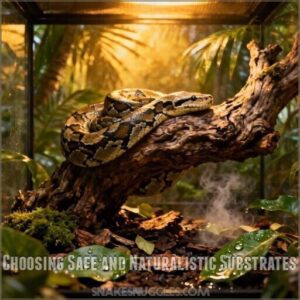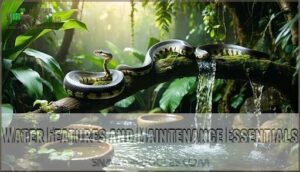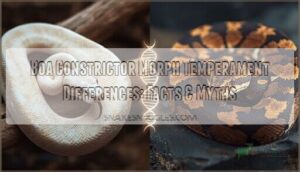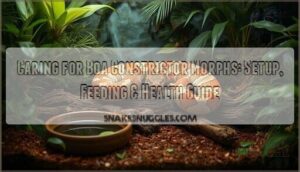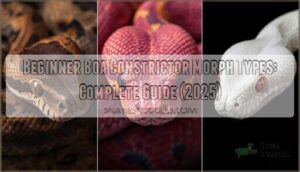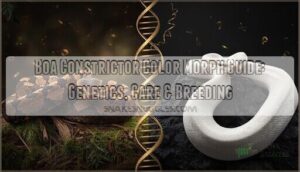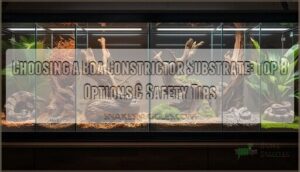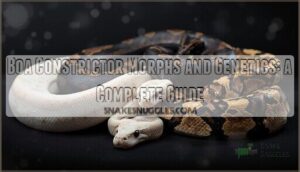This site is supported by our readers. We may earn a commission, at no cost to you, if you purchase through links.
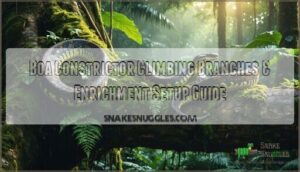
When you deny your boa access to vertical space, you’re not just limiting movement—you’re suppressing instincts honed over millions of years of evolution. The difference between a boa that merely survives and one that thrives often comes down to a single factor: environmental enrichment that honors its arboreal nature.
Proper boa constrictor climbing branches and enrichment transform sterile enclosures into vibrant ecosystems where your snake can express natural behaviors, regulate body temperature efficiently, and maintain the muscular tone that defines these splendid constrictors.
Table Of Contents
Key Takeaways
- Boa constrictors are semi-arboreal snakes that spend roughly half their lives climbing in the wild, making vertical enrichment essential for expressing natural behaviors and maintaining physical health in captivity.
- Proper substrate selection (coconut fiber or cypress mulch retaining 60-80% humidity) combined with bioactive layers creates self-regulating ecosystems that reduce maintenance while supporting natural burrowing and moisture needs.
- Branch diameter must scale with snake size—juveniles thrive on 1-1.5 inch branches while adults require 2-4 inch structures capable of supporting 1.5-2 times their body weight (40-60 pounds for mature specimens).
- Environmental enrichment through rotating decor every 4-6 weeks, incorporating puzzle feeders, live plants, and proper water features reduces boredom-related behaviors and can decrease incomplete sheds by 32% while extending feeding engagement threefold.
Essential Habitat Requirements for Boa Constrictors
Your boa’s captive environment isn’t just a box with a heat lamp—it’s the foundation for everything from healthy thermoregulation to natural behavior patterns. Before you start adding branches and enrichment, you need to nail down the basics: temperature gradients, enclosure dimensions, and the environmental rhythms that keep your snake thriving.
Let’s break down what your boa actually needs to live well, not just survive.
Ideal Temperature and Humidity Ranges
Your boa’s health hinges on getting two things right from day one: a basking zone that hovers between 88-90°F and ambient humidity that stays locked in at 50-60%. Here’s how to nail the climate zones your reptile needs:
- Establish thermal gradients with heat sources on one side—this lets your boa constrictor self-regulate body temperature
- Monitor humidity levels daily using reliable hygrometers throughout the reptile enclosure
- Create multiple microclimates so your snake can choose between warmth and cooler retreats
- Adjust temperature control based on seasonal cycles to mimic natural environmental enrichment patterns
Minimum Enclosure Size and Layout
Once you’ve locked in the right temperature and humidity, the next step is giving your snake enough real estate to actually move—adults need at least 4x2x2 feet, though bigger is almost always better. Smart enclosure design balances ground coverage with vertical layout, creating climbing zones that let your boa explore multiple levels.
| Enclosure Size | Boa Life Stage | Space Optimization Notes |
|---|---|---|
| 3×1.5×1.5 ft | Juvenile | Focus on terrarium planning with accessible branches |
| 4x2x2 ft | Subadult | Minimum for terrarium design with dual zones |
| 6x2x2 ft | Adult | Ideal boa constrictor habitat with full vertical range |
| 8x3x3 ft | Large Adult | Premium snake habitat creation for active climbers |
| Custom Build | Any Size | Reptile enclosure design customized to individual needs |
Importance of Lighting and Photoperiods
Light cycles matter more than most keepers realize—your boa’s internal clock runs on that daily rhythm of dawn and dusk, and getting it wrong can throw off everything from feeding response to stress levels.
Photoperiod effects shape behavior, so aim for 12-hour lighting cycles that mimic natural ambient illumination.
While UVB benefits remain debated in boa constrictor care, proper lighting requirements support color temperatures that reduce stress and sync your snake’s natural rhythms with captive life.
Subspecies and Habitat Variations
Your snake’s Geographic Range determines everything from preferred Climbing Structures to humidity needs—Species Diversity across Central and South America means Habitat Adaptation varies wildly between subspecies.
Ecological Niche differences demand specialized Boa Constrictor Care:
- Rainforest populations need higher humidity (60%+) and abundant branches for Environmental Enrichment
- Dry forest types tolerate lower moisture and prefer ground-level Reptile Habitat Creation
- Riparian zone boas require larger water features and semi-aquatic enrichment
Understanding your boa’s origin shapes effective Conservation Status awareness and captive habitat success. Researching the boa species types is essential for creating a suitable environment.
Choosing Safe and Naturalistic Substrates
The right substrate does more than line the bottom of your boa’s enclosure—it impacts humidity, comfort, and overall health. You’ve got several solid options to choose from, each with its own advantages and trade-offs.
Let’s break down what works best for creating a safe, naturalistic environment your boa will actually thrive in.
Popular Substrate Options (Coconut Fiber, Cypress Mulch, Reptile Carpet)
Choosing the right substrate options for your boa constrictor enclosure isn’t just about aesthetics—it’s a make-or-break decision for humidity control and reptile care success. Coconut fiber and cypress mulch dominate boa constrictor care and maintenance routines because they excel at substrate moisture retention, holding 60–80% relative humidity when properly maintained. Reptile carpet, despite its ease of cleaning, fails to support the humid reptile habitat creation your snake needs to thrive. For ideal results, consider using bioactive substrates to create a natural environment.
| Substrate Type | Humidity Retention | Enrichment Value |
|---|---|---|
| Coconut Fiber | 60–80% (excellent) | Facilitates burrowing |
| Cypress Mulch | 60–80% (excellent) | Natural appearance |
| Reptile Carpet | Live plants are working habitat crew—humidity boosters, shed assistants, and natural hideaways that unlock your boa’s instincts honed over millions of years |
- Choose nontoxic, pesticide-free live plants suited to your lighting and humidity
- Position hides strategically—one on the warm side, one cool
- Layer arboreal design with climbing structures woven through naturalistic decor
This setup lets your boa constrictor explore, ambush, and thrive.
Puzzle Feeders and Sensory Enrichment
You can break bad habits in captive feeding by introducing puzzle feeders that turn mealtime into a hunting expedition.
Foraging strategies like hiding prey behind climbing structures or tucking food in branches boost cognitive stimulation and sensory exploration—your boa spends more time investigating scents, solving obstacles, and engaging its instincts.
This environmental complexity drives behavioral diversity, extending feeding sessions up to three times longer while preventing obesity and boredom in your reptile enclosure design.
Rotating Decor for Ongoing Interest
Once your boa masters a puzzle feeder, swapping branches, hides, and plants every few weeks keeps its mind sharp and prevents it from sleepwalking through the same stale setup.
Decor rotation transforms your enclosure into a vibrant landscape where visual variety drives sensory stimulation—your boa constrictor investigates fresh textures, explores relocated hide boxes, and navigates rearranged climbing structures, maximizing behavioral engagement through continuous environmental enrichment.
Encouraging Natural Climbing Behaviors
Perching above the forest floor is hardwired into your boa’s DNA, so setting up branches that mimic tree limbs and sturdy vines lets it tap into instincts honed over thousands of years in the wild. Branch selection determines whether your boa constrictor masters climbing techniques or ignores vertical space entirely—sturdy, varied-diameter climbing structures across your reptile enclosure design release arboreal enrichment, snake exercise, and ecological enrichment that transform a static naturalistic habitat into a lively behavioral playground.
Water Features and Maintenance Essentials
Water is more than just a survival resource for your boa—it’s a tool for hydration, thermoregulation, and successful shedding. Getting the water setup right means balancing functionality with enrichment while keeping everything clean and disease-free.
Here’s what you need to know about water dishes, humidity management, maintenance routines, and features that keep your boa healthy and engaged.
Choosing a Proper Water Dish
Your boa’s water dish isn’t just a drinking fountain—it’s a multifunctional habitat feature that facilitates hydration, thermoregulation, and successful shedding cycles. Choose a bowl that accommodates at least two-thirds of your boa constrictor’s body length, allowing complete immersion during shedding. Here’s what matters:
- Dish size should accommodate most of the snake’s body
- Water quality requires daily checks and weekly deep cleaning
- Bowl safety means smooth edges and stable placement in the enclosure
- Water temperature should match ambient reptile habitat conditions
- Snake hydration depends on constant access to fresh water
Heavy ceramic or reinforced plastic prevents tipping and maintains humidity levels effectively.
Misting Systems and Humidity Boosters
Maintaining ideal humidity levels between 50-60% requires more than just a water bowl—misting systems and supplemental humidity boosters can transform your boa’s enclosure into a thriving microclimate that promotes healthy shedding and respiratory function.
Automated misting timers deliver precise humidity control without manual intervention, while fogging systems create fine droplets that improve evaporative cooling throughout your terrarium.
Always pair these tools with hygrometer calibration to monitor humidity levels accurately and adjust your boa constrictor’s enclosure conditions based on real-time data.
Regular Cleaning and Health Monitoring
A spotless enclosure doesn’t just look impressive—it’s your frontline defense against respiratory infections, parasites, and stress-related health issues that can silently compromise your boa’s well-being. Establish weekly cleaning schedules for spot-cleaning waste and debris, with monthly deep cleans of all snake enclosures.
During routine enclosure maintenance, conduct health checks—watch for abnormal breathing, skin lesions, or behavioral changes that signal disease. Proper waste management and consistent hygiene practices transform boa constrictor care from guesswork into disease prevention.
Water Features for Enrichment and Shedding
Think of water features as your secret weapon for triggering natural behaviors—boas instinctively seek out aquatic environments for soaking during shedding, and moving water can boost drinking frequency by up to 44%.
Install shallow pools (1.5–3 inches deep) with escape ramps, place them away from heat sources, and clean 2–3 times weekly to maintain water quality.
Pair these enrichment strategies with misting systems for humidity control, and you’ll see incomplete sheds drop by 32% while your boa explores its reptile enclosure like it owns the jungle.
Frequently Asked Questions (FAQs)
How often should climbing branches be rotated?
Regularly swapping out climbing branches—every four to six weeks—keeps your boa engaged and curious. Environmental change prevents boredom and encourages natural arboreal behaviors.
It also provides climbing variety that promotes physical fitness and snake stimulation through ongoing enclosure decor refreshes.
Can boas damage or outgrow their branches?
Yes, your boa constrictor can definitely outgrow climbing branches as it matures. Adults may also break weak structures, creating climbing hazards. Regular inspection ensures branch stability and wood durability, so you can upgrade enclosure décor as your reptile grows.
What weight capacity do branches need?
Like a bridge engineered to hold steady under moving traffic, climbing branches must support at least 5-2 times your adult boa’s weight.
Load capacity matters—most mature boas hit 20-30 pounds, so branches need a 40-60 pound threshold for climbing safety.
Do boas prefer horizontal or vertical branches?
Boas favor horizontal branches for resting but use vertical and diagonal ones to navigate between levels.
Offering a mix of orientations lets your boa constrictor express natural arboreal activity and makes your reptile enclosure design more varied and enriching.
How to sanitize second-hand climbing structures?
Scrub used climbing branches with hot water and dish soap, then soak them in a 10% bleach solution for 30 minutes to eliminate bacteria and parasites before introducing them to your boa constrictor’s terrarium.
Conclusion
Building a proper habitat is like giving your boa the keys to its ancestral home—suddenly, instinct takes over. When you prioritize boa constrictor climbing branches and enrichment, you’re not just decorating an enclosure; you’re unlocking behaviors that keep your snake mentally sharp and physically sturdy.
The investment in vertical space, varied textures, and environmental complexity pays dividends in longevity and vitality. Your boa won’t thank you with words, but its confident movements through a well-designed canopy speak volumes.
- https://www.reptifiles.com/red-tailed-boa-care/boa-constrictor-humidity/
- https://reptifiles.com/boa-constrictor-care/boa-constrictor-substrate/
- https://edenproductsltd.co.uk/2025/05/16/aspen-fibre-vs-coconut-husk-which-is-the-best-snake-substrate-for-wholesalers/
- https://www.imcages.com/en/dust-free-coconut-fiber-substrate-for-snake-medium-551.html
- https://talis-us.com/pt/blogs/blog-47/top-choices-for-best-substrates-for-reptiles-explained

